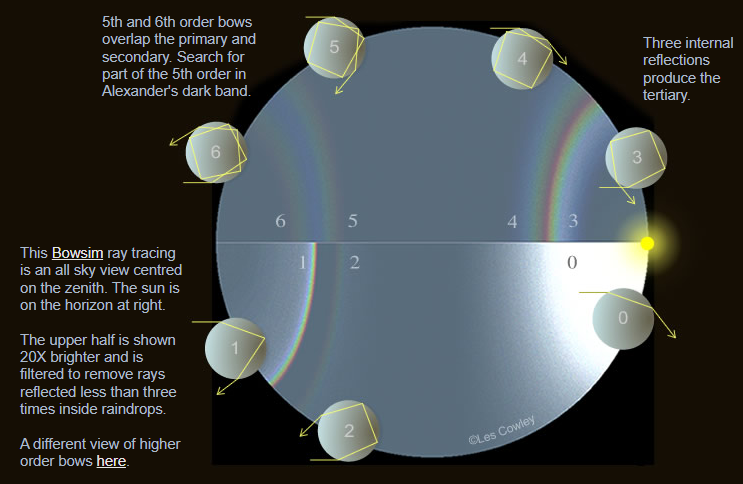Czech Republic Third Order Rainbow - OPOD
Czech Republic Third Order Rainbow - OPOD: A Rare Atmospheric Phenomenon
Rainbows have long fascinated humans with their vibrant colors and ethereal beauty. Most of us are familiar with the primary and secondary rainbows, but did you know that there is a third order rainbow? This elusive and lesser-known atmospheric phenomenon can sometimes be observed under specific conditions. In this article, we will explore the captivating Czech Republic Third Order Rainbow and delve into its unique characteristics.
A Glimpse of the Third Order Rainbow
One fortunate observer, Matěj Grék, captured a stunning view of the fabled third order rainbow in Ostrava, Czech Republic on August 18, 2014. Unlike the more commonly seen first and second order rainbows, the third order rainbow appears sunwards. In the photograph, the low sun is positioned on the left side, partially hidden by a building. The third order rainbow is a remarkable sight that showcases the wonders of atmospheric optics.
Unraveling the Complexity
To fully appreciate the third order rainbow, it's important to understand its formation. The primary and secondary rainbows are created by the refraction and reflection of sunlight within raindrops. In contrast, the third order rainbow emerges due to three internal reflections within the raindrops. This intricate process leads to the creation of the tertiary bow, which adds an additional layer of enchantment to the atmospheric display.
A Closer Look at Higher Order Bows
While the third order rainbow is a remarkable sight, it is not the highest order rainbow that can be observed. In fact, fifth and sixth order bows can overlap with the primary and secondary rainbows. These higher order bows provide even more complexity and beauty to the atmospheric spectacle. If you look closely, you may even spot a part of the fifth order rainbow in Alexander's dark band.
The Elusive Tertiary Bow
The tertiary bow, which is part of the third order rainbow, was first captured in a photograph by Michael Grossmann in 2011. Since then, several images of the tertiary bow have been taken, but it remains a challenging phenomenon to observe visually. It is often overshadowed by the brightness of the sky near the sun and the zero order glow produced by sunlight passing through raindrops without internal reflection.
Characteristics of the Tertiary Bow
Although the tertiary bow is relatively bright, approximately 24% of the intensity of the primary rainbow, it is almost the same size. However, it appears broader and can be easily overwhelmed by the brightness of the surrounding sky. Additionally, the zero order glow interferes with its visibility. These factors contribute to the tertiary bow's elusive nature, making it a captivating yet challenging subject for observation and study.
Enhancing Visibility Through Photography
Interestingly, many sightings of the tertiary bow have been captured through photography rather than visual observation. Photographers have found that by enhancing the photos, they can reveal the presence of the tertiary bow that may have gone unnoticed by the naked eye. This method allows us to appreciate and study this atmospheric phenomenon in greater detail.
In conclusion, the Czech Republic Third Order Rainbow is a rare and captivating atmospheric optics phenomenon. While it may be challenging to observe visually, photography has provided a means to document and study this elusive bow. By understanding its formation and characteristics, we can appreciate the intricate beauty of the third order rainbow and continue to unravel the mysteries of our atmosphere.


Third Order Rainbow
Matěj Grék caught this view of the fabled 3rd order rainbow at Ostrava, Czech Republic on August 18, 2014.
Unlike the well-known 1st and 2nd order bows, the 3rd order is sunwards. The low sun is at left just hidden by the building.
Mouse over the image for a colour subtraction enhancement
©Matěj Grék, shown with permission

5th and 6th order bows overlap the primary and secondary. Search for part of the 5th order in Alexander's dark band.
Three internal reflections produce the tertiary.
This Bowsim ray tracing is an all sky view centred on the zenith. The sun is on the horizon at right.
The upper half is shown 20X brighter and is filtered to remove rays reflected less than three times inside raindrops.
A different view of higher order bows here.
The tertiary bow was first photographed in 2011 by Michael Grossmann. There have been several images captured since but it remains a hard object.
"I did not see anything visually. I just thought that I could take a picture and then try to enhance the photo to actually see it.. ..It was during a moderate rain shower passing overhead and eventually leaving towards north-east. Both primary and secondary bows were visible, along with primary supernumeraries."
The tertiary bow is bright - 24% of the primary - and it is almost the same size. But it is broader and easily swamped by bright sky near the sun. The superimposed zero order glow from sunlight passing through raindrops with no internal reflection also interferes.
Note: this article has been automatically converted from the old site and may not appear as intended. You can find the original article here.
Reference Atmospheric Optics
If you use any of the definitions, information, or data presented on Atmospheric Optics, please copy the link or reference below to properly credit us as the reference source. Thank you!
-
<a href="https://atoptics.co.uk/blog/czech-republic-third-order-rainbow-opod/">Czech Republic Third Order Rainbow - OPOD</a>
-
"Czech Republic Third Order Rainbow - OPOD". Atmospheric Optics. Accessed on December 27, 2024. https://atoptics.co.uk/blog/czech-republic-third-order-rainbow-opod/.
-
"Czech Republic Third Order Rainbow - OPOD". Atmospheric Optics, https://atoptics.co.uk/blog/czech-republic-third-order-rainbow-opod/. Accessed 27 December, 2024
-
Czech Republic Third Order Rainbow - OPOD. Atmospheric Optics. Retrieved from https://atoptics.co.uk/blog/czech-republic-third-order-rainbow-opod/.